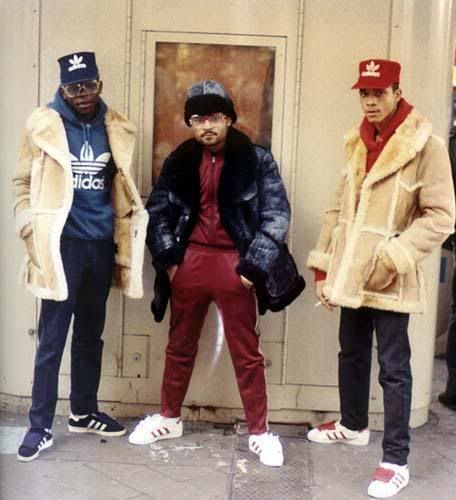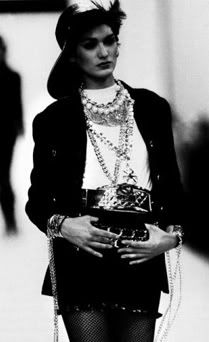
when hip hop first originated in the bronx in the mid seventies, it was a movement that almost inclusively belonged to the poor black and hispanic youths that was looking for an outlet to express their creativity. rapping, graffiti, d.j.ing, and b-boying was the urban form of writing, visual art, music, and dance. what has now been commonly refered to as the four elements of hip hop was the foundation that gave birth to a culture that has since become one of the most influential movements of this generation.
during the early eighties, hip hop was still an urban phenomenon that had little effect on popular culture. it was still segregated in the poor neighbourhoods of the inner cities tucked away into a corner america would rather ignore. however with the birth of video culture popularized by MTV, hip hop was about to break into the mainstream.
with music videos, the image of hip hop entered millions of homes across america. and while many dismissed it as a fad with no longevity, it nevertheless managed to draw in young people who found a connection with it. in 1982 with the release of the highly seminal film wildstyle, which featured now legends such as the graffiti artists dondi, and lady pink, and dancers from the rocksteady crew, it seduced an even bigger audience. as a result of the visual exposion of hip hop in the form of music videos and film, image suddenly became an important aspect. the braggadocio nature of hip hop contributed to its over the top image with filled with big gold chains, phat laces on adidas shell toes, and logo emblazoned clothes to assert the artist's ghetto superstar status.
while the eighties will forever be remembered as the golden age of hip hop, it wasn't until the nineties that its powerful influence was felt, and suddenly, a world caught off guard was seeing it everywhere. even in the rarified world of french fashion.
 for fall/winter 1991, designer karl lagerfeld sent down a collection for the house of chanel that borrowed heavily from hip hop imagery (pictured at left). the iconic chanel chains were reinterpreted into jewelry popularized by rappers such as slick rick or big daddy kane. there were baseball hats with oversized rims done in chanel's classic quilted leather worn backwards or tilted to the side. for such an esteemed house such as chanel, and one that represents the highest acme of fashion, the infiltration of hip hop was to be a preview of just how influential the culture will become. and it wouldn't be long before lagerfeld sent down another collection, this time for spring/summer 1994 that again referenced hip hop and sent down a collection filled with baggy jeans in every colour of the rainbow.
for fall/winter 1991, designer karl lagerfeld sent down a collection for the house of chanel that borrowed heavily from hip hop imagery (pictured at left). the iconic chanel chains were reinterpreted into jewelry popularized by rappers such as slick rick or big daddy kane. there were baseball hats with oversized rims done in chanel's classic quilted leather worn backwards or tilted to the side. for such an esteemed house such as chanel, and one that represents the highest acme of fashion, the infiltration of hip hop was to be a preview of just how influential the culture will become. and it wouldn't be long before lagerfeld sent down another collection, this time for spring/summer 1994 that again referenced hip hop and sent down a collection filled with baggy jeans in every colour of the rainbow.while the early nineties saw a backlash in hip hop with the controversial lyrics of artists such as ice t, or nwa which critics argued seemed to glamorize the "gangsta" lifestyle, record sales were climbing astronomically. but it wouldn't be until the late nineties when hip hop conquers not only fashion, but popular culture as well.
the late nineties saw artists such as mase, foxy brown, and puff daddy to name a few starting to mention fashion labels such as versace, prada, or gucci into their rhymes. while many older hip hop fans grunted at how these new emcees lack substance in their lyrics, the younger generation ate it all up. because of the subject mattern these new artists rhymed about, the music had a more pop sensibility and therefore a broader appeal and it earned the artists millions. and these kids who's never heard of louis vuitton or prada before, are suddenly saving up their allowances so that they could look like the rappers in all the flashy music videos. in many ways hip hop music was the driving force that contributed to the success of luxury brands during the late nineties.
the luxury goods market however wasn't the only one enjoying the revenue hip hop brought them. in the late nineties american designer tommy hilfiger became a sort of status symbol for teenagers and young adults. his mixture of traditional american sportswear and an urban aesthetic with a lower price point became immensely popular and pretty soon other labels such as nautica and polo by ralph lauren began immitating the hilfiger formula.
in the early nineties with hip hop being more aggressive, the hip hop costume also had a confrontational aspect about it. it lost all that aggressiveness and replaced by over the top decadence when hip hop and its artists crossed the commercial pond in the pursuit to earn more money. the music seemed to have been selling a notion of the good life to its avid listeners. where once the music was used as a platform to talk about social issues, this time around the subject matter became more about boasting one's success and possessions. this caused another backlash, but this around around it came from hip hop's own community.
the early two thousands saw the popularity of "underground hip hop". it was a movement that turned away from the frivolousness of mainstream hip hop and its themes were more about social consciousness, intellectualism, afrocentricity, and aimed to bring the soul that the music had lost. with that nostalgia for the past it would only be natural that the clothing of those days would experience a rennaisance. therefore kickstarting the eighties trend that eventually influenced and is still influencing all the eighties inspired looks on the runways and on the streets.
these days hip hop artists have finally clued in on how much high end labels make from their image and many have decided to launch their own fashion labels. while many are geared towards a more urban clientel and have little influence outside the hip hop community fashion wise, many, like kanye west or pharell williams still has the capacity to trigger world wide trends without losing the respect of hip hop heads.
hip hop has been exploited not just by fashion, but by every other industry immaginable. it has sold their products, made them billions, and paid for nothing. but there are those out there who has a deep connection with the culture. where hip hop is a huge part of their life and every memory is intertwined with it.
top photo: jamel shabazz

No comments:
Post a Comment